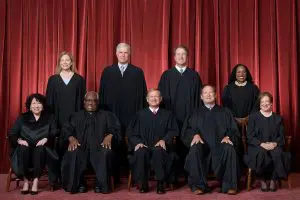FSC v. Paxton: Will the Supreme Court Rule in Favor of Texas?
 WASHINGTON, D.C. – Back in January, after the U.S. Supreme Court heard oral arguments in Free Speech Coalition v. Paxton, the FSC’s challenge to the Texas law, I wrote that while it is “always tricky to predict where the Justices are leaning based on their comments and questions at oral argument, based on a transcript of the hearing, the court seemed potentially divided both as to whether the Fifth Circuit applied the wrong standard of review and whether HB 1181 could survive strict scrutiny, if applied.”
WASHINGTON, D.C. – Back in January, after the U.S. Supreme Court heard oral arguments in Free Speech Coalition v. Paxton, the FSC’s challenge to the Texas law, I wrote that while it is “always tricky to predict where the Justices are leaning based on their comments and questions at oral argument, based on a transcript of the hearing, the court seemed potentially divided both as to whether the Fifth Circuit applied the wrong standard of review and whether HB 1181 could survive strict scrutiny, if applied.”
Since then, another possible clue about the direction the court is leaning has emerged. And while it’s difficult to say whether the clue is dispositive, some of those who watch the Supreme Court closely think it could bode well for Texas in the dispute.
As noted by Amy Howe of SCOTUSBlog.com, “the question the justices agreed to decide was whether the U.S. Court of Appeals for the 5th Circuit properly applied a less stringent constitutional test, known as rational basis review, when reviewing the law, or whether it should have instead applied a more stringent standard, known as strict scrutiny.”
“The justices try to spread out the workload evenly over the course of the term but also on a month-to-month basis,” Howe observed. “The only justices who have not yet written opinions for the court’s January argument session are Justices Clarence Thomas and Ketanji Brown Jackson. It seems more likely that Thomas is writing in Free Speech Coalition (which, based on his questions at oral argument, should bode well for Texas) and Jackson – who once served on the U.S. Sentencing Commission – in Hewitt, but we’ll know soon enough.”
If Justice Thomas is writing the majority opinion in the case, this certainly isn’t good news for the FSC and its co-plaintiffs. At oral argument, Thomas appeared focused on the question of whether technology had evolved since the time the Court decided Ashcroft v. Free Speech Coalition (referred to at the hearing as “Ashcroft II”) in 2002 that some of the Court’s concerns about the burden of complying with age-verification laws have been ameliorated.
“The world of Ashcroft was a world of dial-up Internet,” Thomas said at the hearing, suggesting he might believe technological changes in the interim could change the Court’s analysis.
At the same time, Thomas also raised a question which could indicate he believes imposing age-verification requirements on all adult users might go further than strict scrutiny permits.
“So do you think that it’s appropriate in this context of protecting children to compromise the strict scrutiny?” Thomas asked Brian Fletcher, the deputy solicitor general who argued on behalf of the Biden Administration (which still occupied the White House at the time of the January hearing).
“I wouldn’t describe it as compromising the strict scrutiny standard at all, Justice Thomas,” Fletcher responded. “But I do think it would be appropriate for the Court to emphasize that it’s going to be easier for states to satisfy strict scrutiny in this context because of the very unique nature of the interest here.”
If Thomas buys Fletcher’s reasoning – and enough other Justices do, as well – ultimately, it might not matter much whether they believe the Fifth Circuit applied the wrong standard in its ruling, because even if plaintiffs prevail in getting the trial court’s injunction reinstated, the case is likely to end up back before the Supreme Court, where the law could be upheld on its merits, even with the standard of strict scrutiny having been applied.
As an aside here, it’s worth noting that while the court has a conservative leaning these days, opinion among conservatives outside the court isn’t entirely united on the question of whether state age-verification laws represent good policy.
In a post published last November on the website of the Federalist Society, David Rubin, an attorney with the Foundation for Individual Rights and Expression (FIRE) and member of the First Amendment Lawyers Association (FALA), argued that “the Court should reverse the Fifth Circuit’s attempt to overrule a quarter-century of its precedent from below.”
Criticizing the Fifth Circuit for applying the wrong standard of review and side-stepping issues the Supreme Court had identified in earlier cases, Rubin wrote that these rulings “underscore that when lower courts simply ignore First Amendment standards they dislike, they imperil constitutionally guaranteed free speech rights.”
“Ensuring minors’ safety is an important and worthy objective, but the means of accomplishing this goal must be constitutional,” Rubin added. “If the Supreme Court allows the Fifth Circuit’s rejection of settled precedent to stand, lawmakers and lower courts will declare open season on previously established law, resulting in a jumble of inconsistent protections for First Amendment rights across the country. By simply following its straightforward internet-speech precedents and requiring that Texas’ age-verification law satisfy strict scrutiny, the Court can avoid this constitutional patchwork and safeguard adult free speech rights as the First Amendment requires.”
We’ll know soon enough which way the court has been leaning – and then the case can return to litigation in the lower courts, possibly guided by a different set of First Amendment guardrails than in past cases.













